 Полная версия
Полная версияThe Day After Death (New Edition). Our Future Life According to Science
Theophilus. Your reasoning is just. But you must prove, or, if you prefer the phrase, you must teach me that the universe is truly The Infinite by its extent. I could not admit that assertion without very convincing evidence.
The Author. Very well. Lend me your best attention, and excuse me if my demonstration resembles a lecture on astronomy. I have said that our solar system is only a little corner of the universe. When you look at the vault of the sky on a bright clear night, you see it thickly strewn with stars, which, you will at once acknowledge, it would be impossible to count. But all that you see with the naked eye is next to nothing. Take a good telescope, and direct it to any part of the sky. There where a moment before you saw nothing, you will now discern legions of stars, bright spots will come out upon the darkness of space, like diamonds upon the velvet lining of a casket, each of them a star, exactly like those which we see at night in the sky. And now, let me ask you, do you know what a star is?
Theophilus. Yes, I know from your manuscript, and I had already known, that the stars which we see by night, but which the greater light of the sun hides from us in the day-time, are self-luminous orbs, each the centre of attraction and the lamp to the particular world it lights, and which revolves around it. As a whole company of planets, satellites, asteroïds, and comets revolve round our sun, receiving heat, motion, and light from that great central orb, so, the stars dispersed throughout space, communicate motion and activity to a vast aggregate of planets and satellites. These planets, which revolve round the stars, constitute stellar worlds, analogous to our solar world. We cannot see the planets, which accompany these stars, by reason of their smallness, and the prodigious distance between us and them, beyond the reach of the most powerful telescopes; we only see the suns which govern them, i.e., the stars. But the existence of the fixed stars, like our sun, implies the existence of planets revolving around them.
The Author. Perfectly correct. Thus, our solar world is not unique, it is only one member of the family of stellar worlds, which resemble our world in the disposition and the motions of the stars within them. The universe is composed of the agglomeration of them all. You know all this, but there is one fact which, as it is the result of recent discoveries, you may not be aware of; it is, the great variety of disposition or of physical aspect presented by certain stars, in which a kind of overturn of that which constitutes nature on our globe has taken place. While they remain similar to our world in the order of their movements, certain stars differ widely in the forces which govern nature in them.
Theophilus. Pray explain your meaning.
The Author. While our solar system is governed by a single central star, there are stellar systems which are governed by two, three, and even four suns. It is evident that worlds which have two or three centres of light and heat must present physical and mechanical peculiarities of which we have no idea. There are also other differences proper to many of the stellar worlds. The light of our sun and of the greater number of the stars is constant: it never undergoes either augmentation or diminution. But this is not the case with many of those distant suns which we call stars. We see their light alternately fade and revive; sometimes they shine brightly, then become almost imperceptible, and anon brilliant again. Some of them become altogether extinct. The decrease in lustre of several stars has been noted by different astronomers.23
Stars which have been observed in other times no longer exist.24 Others have suddenly appeared, shone with excessive lustre, and at the end of some years have been seen no more.
These successive augmentations and diminutions of luminous brilliance are not uncommon in the stars with which we are acquainted. According to M. Flammarion,25 star ο of the Whale varies very much in luminous intensity and the constellation itself frequently disappears. Star χ of the Swan passes from the fifth to the tenth size under our eyes, the thirtieth star of the Hydra, which is of the fourth size, almost always disappears at intervals of 500 days. These variations must, as M. Flammarion observes, produce strange results. To-day, the radiant star is shedding floods of light and fire upon the planets which it governs, and the soul of that planet is warmed by its burning rays. A few months later, without the least cloud in the sky, the shining of the sun becomes fainter, and then, by degrees, the obscurity increases, until at length the planet is plunged into thick darkness. When the diminution of the light of the sun is periodical, this universal night lasts for a fixed time, at the end of which the light returns, if not, the darkness is dispersed after varying periods. The light grows, little by little, until at length the radiant star reappears in all its primitive brightness. The fine days, the glorious light returns, until the moment when the same fading recommences and the darkness sets in once more.
Can we picture to ourselves the strange alterations which nature undergoes in regions which are subjected to torrid heat and glacial cold by turns? I am convinced that the glacial period which geologists have defined in the history of our globe, during which an extraordinary and sudden lowering of the temperature caused the death of multitudes of living beings, and covered Europe with glaciers from the mountains—was caused by a momentary weakening of the intensity of the sun's light. When it resumed its ordinary brightness, the sun dispersed the ice which had covered the earth with a death mantle.26
I have said that there are double stars, that is to say, worlds illuminated by two suns, and sometimes even by three or four. It is a strange fact that in almost every instance one of these suns is white, like ours, but the second is coloured, blue, red, or green. In the constellation Perseus for example, a double star can be distinctly seen by the aid of a good telescope. The star η is in fact accompanied by a second, which makes part of the same solar system. Now, this second star is blue. In the constellation Ophiochus there is a similar system of double stars, one of which is red and the other blue. The same peculiarity exists in the constellation of the Dragon. In a double star of the constellation of the Bull, there is a red sun, and a blue sun. There are double solar systems red and blue; such are the constellations Hercules and Cassiopœia. Other double solar systems are yellow and green, and sometimes yellow and blue. In all the worlds which are illuminated by these coloured suns, the effect of light must be very strange. No painter could represent them, and indeed we, who know only the white light of our own sun, cannot form any idea of them.
Theophilus. These features of the stellar worlds are very interesting, and I am glad to learn them. But are we not straying from our subject?
The Author. No. After having made you understand that the solar system which we inhabit is only a member of an immense family of other solar worlds, only a small fraction of the universe, I wished to show you by the diversity of those worlds, the facility with which nature varies the forces and the physical conditions proper to the stellar worlds, and consequently the living and inanimate types which make a portion of these different stellar worlds. Now that you understand the prodigious diversity of the solar worlds which compose the universe, I will go on to our principal object. I have not lost sight of my intention of proving to you that the universe has no limits, that in its extent it is really the Infinite. I am now approaching this great question. By the consideration of the stars, I am going to bring out into relief the immeasurable vastness of the universe. Let me speak, first, of the appalling distances which separate the stars from the earth, and the figures will show you that on that side we fall into the Infinite, and then I will speak of the numbers of the stars which people space; and on this side also the abyss of the Infinite will yawn before us. First, as to the distances which separate the stars from the earth, from whence we may logically infer the distances which separate these stars from one another. The distance between the earth and the sun is 38,000,000 leagues, and this shall be our unit, our standard of measurement, by which to estimate the distance of the stars.
I do not know, my dear Theophilus, whether you have formed an exact idea of this extent of 38,000,000 leagues, which lie between us and the sun. In general, we can only conceive prodigious distances such as astronomy deals with, by representing them by the interval of time which certain movable bodies known to us would consume in traversing them. Let us then have recourse to comparisons of this kind. A cannon-ball weighing 12 kilogrammes, exploded by 6 kilogrammes of powder, proceeding at a uniform rate of 500 metres a second, would take 10 years to travel from the earth to the sun.
Supposing sound to travel at the same rate as on the surface of the air, and at a uniform rate, it would take 15 years to accomplish this journey. If a railway were laid through space between the earth and the sun, a train travelling at express speed, 12½ leagues an hour, would not arrive at its destination until the end of 338 years. This imaginary train, if dispatched from the earth in January, 1872, would arrive at the sun in the year 2210. The light from the sun, which travels 77,000 leagues in a second, takes 7 minutes 13 seconds to reach the earth.
Theophilus. The distance between the earth and the sun is, then, 38,000,000 miles—that is our unit of measurement for the distances of the stars. Now let us hear about these distances.
The Author. I will deal first with those stars which are nearest to us. One of these is a star in the constellation of the Swan. This star is distant from the earth 551,000 times our unit of measurement, that is to say, that we must multiply 551,000 times the distance of the earth from the sun to represent the distance of the star which we are considering, and yet it is one of the nearest to the earth. If we wish to represent this distance by the time occupied in the transit of light, supposing this light to travel, like that of our sun, 77,000 leagues a second, it would take 9½ years to travel from the star to us.
Now, if you wish to know the distance of other stars, and remember that I only speak of the nearest, look at this table, which I found in an astronomical treatise:
DISTANCE OF CERTAIN STARS FROM THE EARTH.
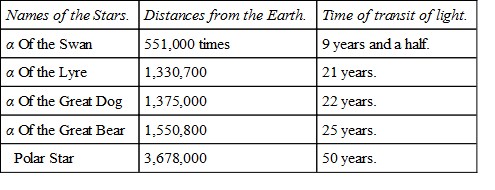
Thus, the star α of the Lyre is distant from us more than 1,330,000 times as far as the earth is from the sun, and its light takes 21 years to reach us. If, by any celestial catastrophe, star α of the Lyre were to disappear, to be annihilated, we should still see it for 21 years, as its light takes that time to reach us.
Theophilus. It is then possible that our astronomers are now observing stars which no longer exist, and are only visible to us because the light which they omitted is still travelling towards the earth.
The Author. Just so. But to continue. I have begun with the stars which are nearest to the earth. There are the stars of first and second magnitude. You know, I suppose, the signification of those terms first, second, and third magnitude in astronomy?
Theophilus. Yes, I know that the word magnitude is only applied to the luminous appearance of the star, and not to its real bulk. A star of the first magnitude is one which forms part of the group of the most luminous stars; a star of the second magnitude is one which comes next in point of brilliancy.
The Author. You must bear in mind that the word magnitude signifies in astronomy the opposite of that which it expresses. The more luminous a star appears to us, the nearer it is to us; the paler and less visible, the farther it is away. The brilliance diminishes in proportion as the figure increases. This is an introversion of terms, sufficiently exceptional to be taken note of, and it ought to be remembered, for fear of mistakes. Hitherto we have considered only stars of the first and second magnitudes. Those of the third, fourth, fifth, and sixth, lead us to the contemplation of such immense distances, that the unit which we have adopted, enormous as it is, is no longer of use. The instruments of celestial observation which may be applied to the examination and measurement of stars of the first and second magnitudes, do not serve for stars of the third and following magnitudes, and, because the small visible diameter of those stars make them appear mere specks of light, measuring instruments are equally inapplicable to them. In estimating the distances of the stars after the third magnitude, a method of comparison, based on the amplifying power of the telescopes successively used, is employed. I cannot enter into details of this method, which we owe to Sir William Herschel, but must content myself with explaining its results, which are as follows in the case of stars of the sixth magnitude. From certain stars of that class, light would take 1042 years to reach us: from others it would take 2700. After the sixth magnitude, the stars can only be discerned by the aid of the telescope, and their distances become perfectly stupefying in immensity. Certain of these telescopic stars are so far from the earth, that their light can only reach us in 5000, and even 10,000 years after it leaves the luminous centre. From the stars of the last category (fourteenth magnitude), light would take 100,000 years to reach the earth, supposing it to travel at the same rate as the light of our sun, i.e., 77,000 leagues per second.
Theophilus. But, if we are to accept the results of the labours of recent naturalists, man exists on the earth only within 100,000 years, and some of those stars may have been extinct during all that time, so that the human race may have been contemplating stars no longer in being for 100,000 years. To what strange consequences does such a science lead us!
The Author. Yes, the luminous rays which these stars send us from the deepest depths of space may perhaps be emanations from solar systems no longer in existence. The present shows us only the past. There may be stars so profoundly lost in immensity, that their light has not yet had time to reach us. They exist, but we cannot see them, not because the telescope could not discover them, but because thousands of centuries are required for the journey of their luminous rays to our earth, and those thousands of centuries have not yet elapsed; so that this grand spectacle is reserved, in that awfully remote future, for our descendants.
And now, my friend, will you not acknowledge with me, that the universe, considered merely by the distances which separate us from the stars, and the stars from each other, is truly the Infinite?
Theophilus. Yes, it is the Infinite which unfolds itself before my eyes. Let me breathe a moment.
The Author. If we contemplate the number of the stars, we shall also have the perspective of the Infinite. It is easy to reckon those of the first magnitude, i.e., the nearest to us. They are 20. Those of the second magnitude are 65; of the third, 170. The number of the stars increases as their visibility diminishes, in a very rapid proportion. The number of stars of each class of visibility, in apparent magnitude, is three times greater than that of the stars of the preceding class. There are 500 stars of the fourth, 1500 of the fifth, 4500 of the sixth magnitudes. The stars visible by the naked eye are 6000 in number. A practised eye can succeed in counting the 6000 stars in the two hemispheres.
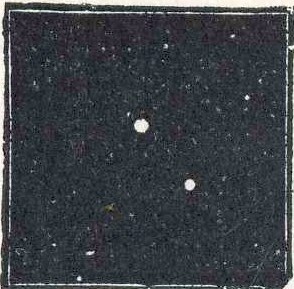
Fig. 6.—A Corner of the Constellation of Gemini.
But the telescope enables us to push the numbering of the suns much farther: it opens up to us the depths of the heavens. Instead of the small number of stars which our eyes can see, it shows us a myriad of others, so thickly thronged together that they seem to cover the sky with fine silver sand. Here, for instance (fig. 6), is the aspect which one corner of the constellation of Gemini presents to the naked eye. And here is the same portion of the sky seen by the telescope. By the aid of this wonderful instrument stars of the thirteenth and fourteenth magnitudes have been distinguished. The number of stars of the twelfth magnitude is 9,556,000, which, joined to the number of the same stars proper to the preceding categories, gives a total of more than 14,000,000. In the third magnitude, a total number of 42,000,000 of stars is counted. Thus, reckoning those visible to the naked eye, and by the telescope, we have 56,000,000 of suns, and we stop at this number only because the telescope does not enable us to see smaller stars than those of the fourteenth magnitude. But, let the telescope be brought to greater perfection, and the whole region of the sky will be seen to be covered with this silver sand, with this diamond dust, of which each grain is a sun. And such will be the accumulation of these suns, in the depths of space, that nothing will be seen on the field of the telescope but a luminous network, formed by the agglomeration of the suns, which will appear to touch each other.
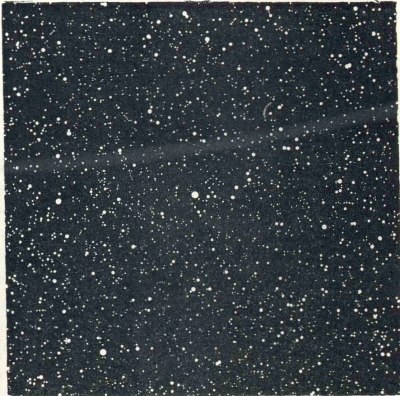
Fig. 7.—A Corner of the Constellation of Gemini, seen through the telescope.
Theophilus. The Infinite is beginning again. Let me shut my eyes.
The Author. Wait, I have not said all, I have only begun. I am coming to the nebulæ. Here, indeed, you may expect to grow giddy. The telescope has dispersed all the theories on which the different explanations of the nebulæ were built, and has shown us that they are collections of stars, which, in consequence of their excessive number, and their closeness to each other, appear to form a whole, a single vague and continuous brightness. But, when their dimensions and distances are amplified by the telescope, this diffused light transforms itself into a brilliant point, analogous to that presented by the sky, tapestried with small stars, in the same telescope. These nebulæ are groups of enormous numbers of stars, and even their nearness to each other is only in appearance. They are, in reality, separated by enormous distances, and it must not be supposed that they are all in the same plane; they belong, on the contrary, to very unequal depths in space, and it is only an optical effect which gathers them together on the field of the telescope in the same apparent plane.
The nebula of the Centaur is one of the most wonderful. To the naked eye it is but a dimly-lighted point in the sky; but, looked at through a good telescope, it takes the aspect represented by figure 8.
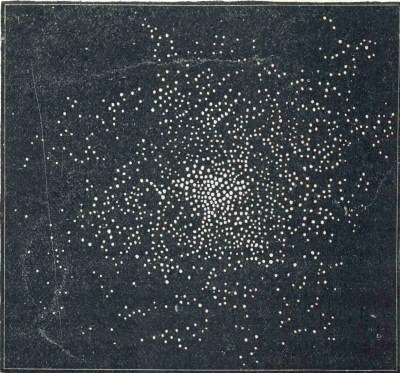
Fig. 8.—The Nebula of the Centaur.
On examination of this figure, it will be seen that a nebula is not the result of a collection of stars simply spread out upon a level in space, but of that of an assemblage of stars all placed at unequal distances, and forming almost a sphere. In fact the stars are crowded towards the centre, and are, on the contrary, more and more distant from one another as the outer edge is approached. If a spherical assemblage of stars were observed from a distance, it would present a similar aspect. This leads us to believe that the nebula of the Centaur, like the greater number of agglomerations of this kind, is spherical.
Is it possible to reckon the stars which form a nebula? Only approximately. Arago estimates the number of stars which form a nebula no larger than the tenth part of the apparent disc of the moon, at twenty thousand, at least. This result may give us an idea of the swarms of suns contained in the nebulæ, for these stellar masses are very numerous in the sky. In the depths of the nebulæ there are luminous points whose nature is as yet unrevealed by the telescope, which cannot be resolved into stars; but analogy leads us to believe that they are other and still more distant nebulæ, which, by reason of their apparent littleness, elude the scope of our instruments. But the time will come, when, thanks to the perfection which our telescopes shall have attained, this theory will be confirmed, and we shall thus see deeper and farther into immensity.
The stars which form the nebulæ are sometimes grouped so as to form regular shapes, spheres, or more or less lengthened ellipses. Sometimes the sphere is hollow in the centre, and so forms a ring. Nothing more varied, nothing more strange can be imagined than the forms of those nebulæ which have hitherto been examined, and which already number more than a million, of which no two are precisely alike. Certain nebulæ seem to be double, or joined. Others are lengthened out, like serpents, as in that of the Shield of Sobieski, represented in figure 9.
Lord Rosse was the first to discover that curious disposition of the nebulæ called spiral.
Such a form is inexplicable, but it is certain that the suns which compose the nebulæ are often grouped, not around a centre, not in shapeless heaps, but in regular curves, on a system which seems to reveal the existence of some mysterious force acting upon those stars, which are distributed along lines representing spirals of different diameter.
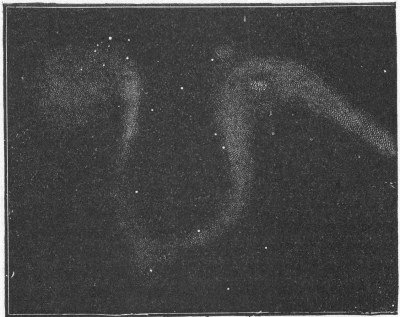
Fig. 9.—The Shield of Sobieski.
In speaking of the stars, I have said that there are coloured stars or suns. I will add here that nebulæ are observed coloured red, green, and yellow, which is an additional proof that they are only agglomerations of stars. That immense semi-luminous band which traverses the celestial vault, girding it with a silver belt, is not, as it was long supposed to be, a diffused quantity of luminous matter. The telescopic analysis of the Milky Way shows that it consists of a long series of nebulæ. The length of the Milky Way is from 700 to 800 times the distance from Sirius to the sun, a distance which is 1,373,000 times that from the earth to the sun.27
Theophilus. Can any idea be formed of the number of stars comprised in the Milky Way?
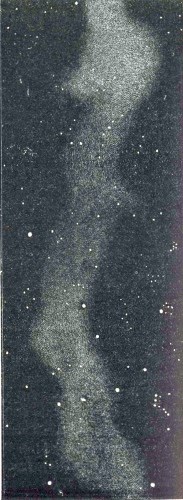
Fig. 10.—The Milky Way.
The Author. Herschel, having examined the sky of the southern hemisphere from the Cape of Good Hope, in applying his observations to the whole extent of the Milky Way, estimated the number of suns comprised in that immense nebulæ at 18 millions. I have just told you the length of the Milky Way. A ray of light emitted from a star at one of its extremities, and reaching the other, would take 15,000 years to accomplish the transit. So that, when we are looking through the telescope at one of the suns of this nebula, we receive the impression of a ray of light emitted from that star 7000 or 8000 years ago, i.e., long before the dawn of the historic ages.28 The measurement of the Milky Way enables us therefore to measure the extent of other nebulæ, still more distant from us. There are, as I have already said, masses of diffused light in the midst of nebulæ which telescopic analysis has resolved into stars, which are probably much more distant nebulæ. The real distance of these luminous masses can be fixed. If it were asked, to what distance the Milky Way should be removed in order to offer us the aspect of an ordinary nebula, Arago would answer that according to his researches, the Milky Way ought to be removed to a distance equal to 334 times its length. According to this the Milky Way would be seen from the earth at an angle of 10°, and its light would take 5,010,000 years to travel that distance. Thus, light would take more than five millions of years to travel from one of the telescopic nebulæ to our earth. Such are the intervals which exist in the universe, and which our instruments can appreciate. It seems to me that we are now on the borders of the Infinite.



